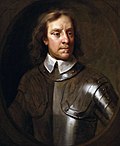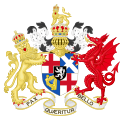Cromwellian Commonwealth
The Lord Protector of the Commonwealth of England, Scotland and Ireland was the title of the head of state and head of government during the Commonwealth [1] (often called the Interregnum), following the first period when a Council of State held executive power. The title was held by Oliver Cromwell [1] [2] (December 1653 – September 1658) and subsequently his son and designated successor Richard Cromwell (September 1658 – May 1659) during what is now known as The Protectorate.
The 1653 Instrument of Government (republican constitution) stated:
Oliver Cromwell, Captain-General of the forces of England, Scotland and Ireland, shall be, and is hereby declared to be, Lord Protector of the Commonwealth of England, Scotland and Ireland, and the dominions thereto belonging, for his life.
The replacement constitution of 1657, the Humble Petition and Advice, [1] gave "His Highness the Lord Protector" the power to nominate his successor. Cromwell chose his eldest surviving son, the politically inexperienced Richard. That was a non-representative and de facto dynastic mode of succession, with royal connotations in both styles awarded (even a double invocation 16 December 1653 – 3 September 1658 "By the Grace of God and Republic Lord Protector of England, Scotland and Ireland") and many other monarchic prerogatives, such as that of awarding knighthoods.
Richard Cromwell, who succeeded after his father's death in September 1658, held the position for only eight months before he resigned in May 1659. He was followed by the second period of Commonwealth rule until the Restoration of the exiled heir to the Stuart throne, Charles II, in May 1660.
Lords Protector (1653–1659)
| Lord Protector | Lifespan | Term began | Term ended |
|---|

Oliver Cromwell
| (1599-04-25)25 April 1599 –
3 September 1658(1658-09-03) (aged 59) | 16 December 1653 | 3 September 1658 (Died) |

Richard Cromwell
| (1626-10-04)4 October 1626 –
12 July 1712(1712-07-12) (aged 85) | 3 September 1658 | 25 May 1659 (Resigned) |
This page is based on this
Wikipedia article Text is available under the
CC BY-SA 4.0 license; additional terms may apply.
Images, videos and audio are available under their respective licenses.



